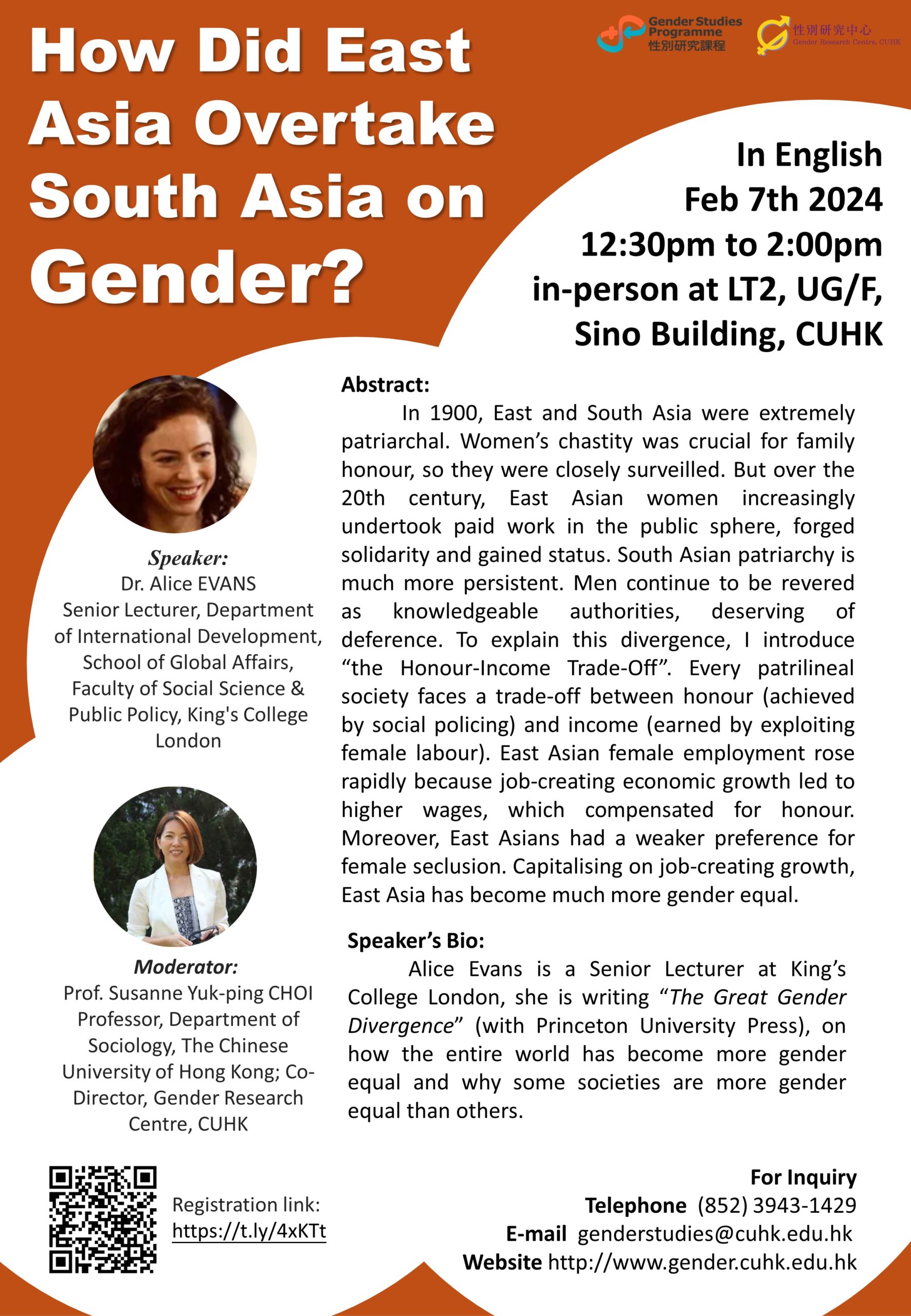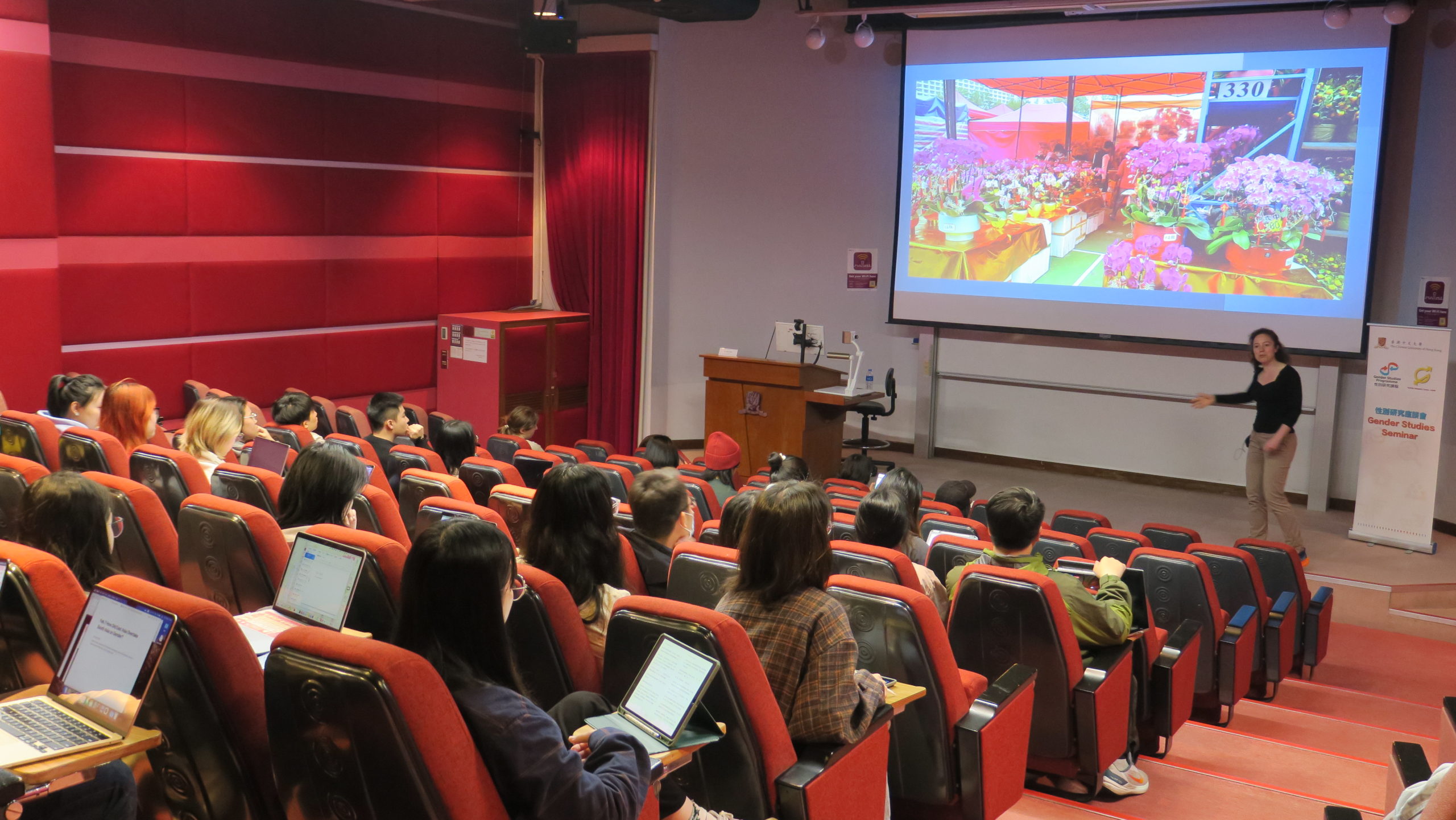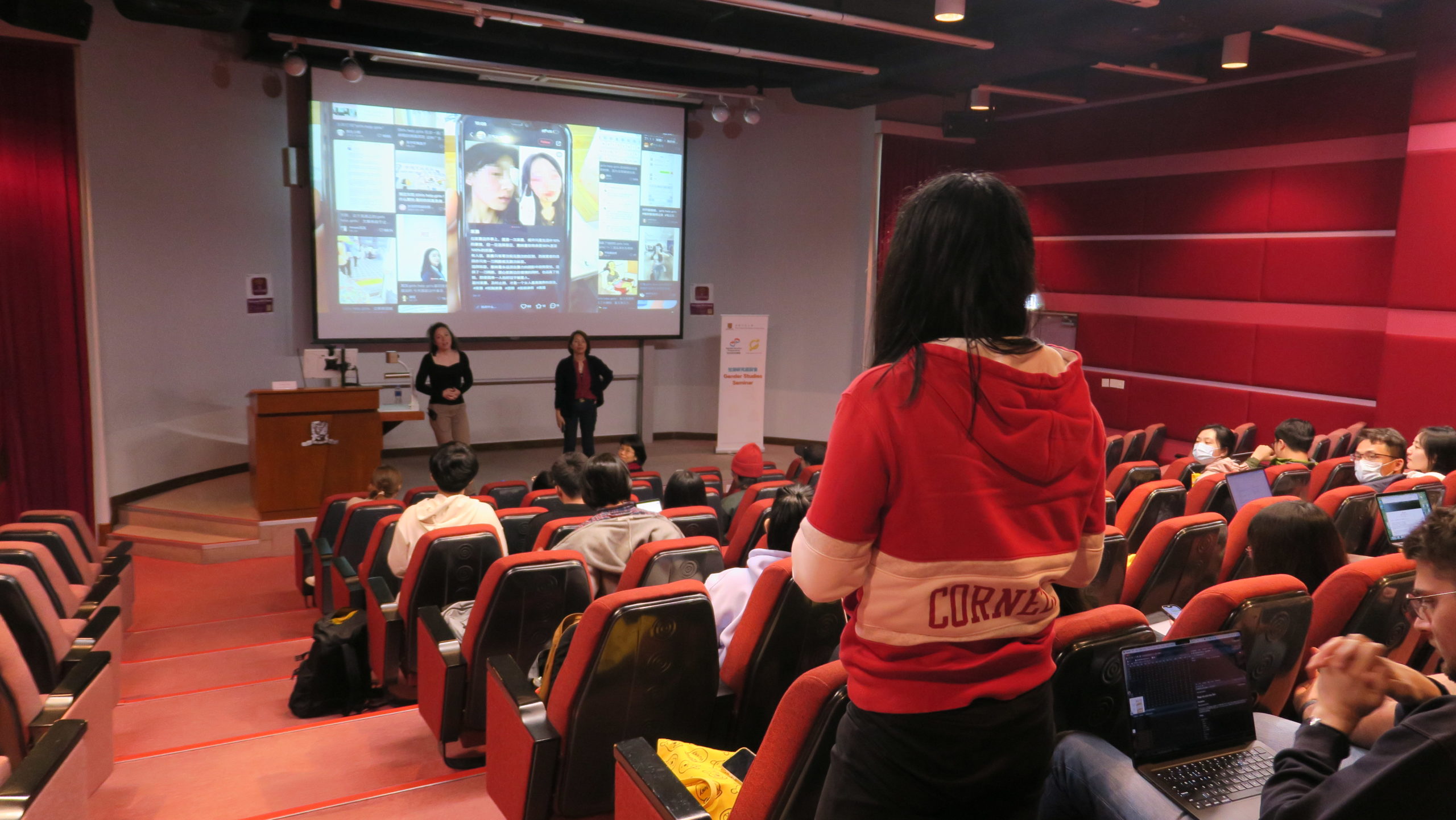Both East and South Asia are polarized patriarchal societies, whereas over time, women in East Asia have begun to engage in paid work in the public sphere and have gradually gained a higher social status in comparison to the South Asia. Dr. Alice Evans introduces an essential concept “the Honour-Income Trade-Off”. Based on this concept, the reasons for gender divergences in East and South Asia can be categorized as follows.
On the one hand, there is relatively limited attention to female segregation in East Asian families compared to South Asian families. Therefore, women have seized the opportunity of rapid industrialization to obtain job opportunities, gaining an economic income outside the family and achieving the first step towards independence, which has liberated them and raised their social status. East Asian countries are realizing that women are the best labor force, which has led to large-scale employment of women, then women’s self-reliance has brought about a mental and material shift away from traditional thoughts.
On the other hand, progress towards gender equality has been much slower in South Asia. The cultural traditions in South Asia are difficult to break through, as women are constrained to marry early and stay at home due to the strict constraints of men’s families, social networks, and religion. At the same time industrialization in South Asia has not created enough employment opportunities, women rarely go out to work. The overall economic development in South Asia is slow and women’s income is limited by caste restrictions that do not compensate for cultural preferences.
The seminar used a new lens to explain the differences in gender equality between East and South Asia, with cultural and economic differences contributing to a very different picture. As a woman in an East Asian context, I have clearly felt this transformation over the years. It is imperative for women to break free from patriarchy to create economic opportunities and empower us.
Written by: CAO, Jun
This lecture is titled How Did East Asia Overtake South Asia on Gender? Dr. Evans introduced the phenomenon that East Asian society shows more gender equality than South Asia with some possible factors by illustrating statistics data and charts.
First, Dr. Evans introduced one concept of the Patrilocal Trap of Asian society. She pointed out that South Asia remains a higher level of family-based social structure than East Asia, and held several examples to support her viewpoint, including the difficulty of getting a divorce, the different methods of class mobility, and the fact that elite women gave up labor ability by restrictions such as heavy suits and foot bonding.
Second, another model concerning the Honor-Income Trade-Off was shown to discuss how the impact of individual labor under modern manufacturing mode reacting to traditional social culture. One basic idea is that the more economic profits female labor could take back home, the better status and mentality women get, though this model still be influenced by solid cultural structure. Dr. Evans harbors the idea that the strong belief in religions resulted by stable ranks in South Asia can make people there pay more attention to Honor for ending in afterlife paradise instead of money even if they’re poor, thus the attraction of income can be very weak to people in South Asian areas.
At last, Dr. Evans demonstrated graphs and charts to give statistical data to discuss how cultural liberalization beat economic development in South Asia, obviously, East Asian society is comparatively a place that has more free class mobility, more individual initiative without religious restrictions but only loyalty to the Ruler. This made East Asian women become more valuable in contemporary economic activities, and it may explain why East Asia can overtake South Asia in gender equality, which is also the key finding helping listeners to understand more about Asian gender normativity from a social perspective.
Written by: CHEN, Liqi
在2月7日的週三性別研討會上,來自倫敦大學國王學院的高級講師Alice Evans介紹了她的著作《性別大分化》(The Great Gender Divergence)中的一個章節:“東亞如何在性別上超越南亞?”
大約在1900年,東亞和南亞都屬於極端的父權社會,二者都陷入從夫居的陷阱(The Patrilocal Trap)中。婚姻的作用在於維繫和鞏固可信賴的商業和合作網絡,通過包辦婚姻,並要求女性侍奉丈夫、孝順公婆、從一而終,東亞和南亞家庭賴以生存的社會關係網絡得以鞏固。但在20世紀,東亞逐漸克服了從夫居的陷阱,越來越多的女性在公共領域從事有償工作,建立團結並獲得地位。然而,南亞的父權制更為頑固,男尊女卑、性別歧視和暴力仍是常態。
對此,Alice基於文獻研究法,以及她在東亞與南亞的定性訪談和田野調查的發現,引入了“名譽-收入權衡”(The Honour-Income Trade-Off)來解釋東亞與南亞在性別平等程度上的差異。Alice認為,每個父權制家庭都面臨著名譽(通過社會監管實現)和收入(通過剝削女性勞動力獲得)之間的權衡。男性希望通過各種形式的社會監管將女性隔離在家,以限制她們的經濟獨立並確保女性的貞潔,從而維持自己受人尊敬的權威地位和家庭名譽。然而,對女性的監管和隔離越多,家庭就越不能剝削她們的勞動力以換取經濟價值。因此,儘管社會理想是讓女性留在家,但有的家庭為了填補收入可能會選擇讓女性出去工作。然而,這必須與潛在的名譽損失進行權衡。Alice發現,受到經濟增長和文化的影響,東亞和南亞在名譽和收入之間所做出的權衡存在顯著的差異:南亞更注重監管和隔離女性;而東亞對於隔離女性的偏好較低,家庭更願意女性外出工作以換取收入。
Alice認為,東亞與南亞不同的社會文化背景是導致它們在名譽與收入權衡上存在差異的一個重要因素。這主要體現在不同的社會流動性,以及對物質和宗教的不同關注上。Alice將中國的科舉制度與印度的種姓制度進行比較,指出在以中國為核心的儒家文化圈中,統治者為了削弱世族的勢力以鞏固皇權,誕生了科舉制度這種相對公平的選拔機制,不論出身貧富,只要是熟讀儒家經典的男性均有機會通過考試來獲得地位和榮譽,這加強了社會流動的循環,人們相信能夠通過自己的努力來改變未來。因此東亞的文化更加關注當下的物質繁榮和成功。為了獲得更多財富,東亞家庭並不想將女性限制在家,而是傾向於讓女性外出工作掙錢。然而在南亞,種姓制度是一個嚴格的等級制度,人們的社會地位主要由出生所決定,幾乎沒有社會流動性。因此南亞的文化側重於宗教,人們相較於今生今世的物質繁榮更加關注神明、天堂和來世,嚴格的社會監管以及經濟激勵的缺乏使南亞女性更多的被隔離在家。
此外,Alice指出東亞與南亞不同的經濟發展水平也是導致名譽與收入權衡存在差異的重要原因。20世紀東亞工業化迅速發展,對勞動力的需求非常旺盛,經濟增長帶來了更高的工資,這增加了東亞家庭,尤其是農村貧困家庭限制女性的機會成本。此外,東亞由於結婚年齡較晚,有大量的未婚女性可以同時被雇用,這種同步效應有助於東亞家庭克服對名譽損失的擔憂,因而更加願意利用女性勞動力來應對新的經濟機會。
Alice強調,經濟發展本身可以鼓勵文化自由化。東亞經濟的快速增長促進了文化自由化,幫助東亞克服了從夫居的陷阱,進一步推動了性別平等。收入的增長以及從農村到城市的遷移削弱了東亞家庭對親屬關係網絡的依賴,女性不再以家庭為中心,可以自主決定生活方式而不用與夫家住在一起。婚姻的意義已經從鞏固可信賴的人際網絡轉變為尋求幸福,人們對離婚的接受度大大提高。名譽越來越多地以經濟上的成功而不是儒家思想來定義,收入更加受到重視,東亞女性優先考慮經濟獨立,父母也越來越依賴女兒經濟上的支持。隨著越來越多的女性進入職場並掌握話語權,她們在社交媒體、影視作品等領域公開倡导性別平等,抵抗父權,譴責暴力,推動新的文化理念。然而南亞由於經濟發展緩慢,家庭依然嚴重依賴親屬網絡,女性收入低微而不能彌補名譽的損失,所以她們依舊被隔離在家,深陷在從夫居的陷阱中。
Written by: CHEN, Peiwei
Alice Evans教授的本次講座內容是關於東亞與南亞地區的性別問題。她的研究包含了縱向與橫向兩個維度,在橫向時間軸維度上,她闡述了東亞與南亞的性別狀況是如何變化與發展的,並探討了背後蘊含的社會文化根基;同時,她通過縱向比較兩地區的社會現狀,指出隨著經濟的發展,東亞已在性別平等問題上超越南亞,取得了巨大進步。
儘管國家之間的社會習慣和文化習俗存在差別,但是亞洲地區因緊密的地緣關係和強勢的父系權力結構,不約而同地形成了“父系地方陷阱/圈套”(the patrilocal trap)。具體表現為,在東亞和南亞的父系社會權力結構下,婚姻是完成從父權到夫權對女兒的權力支配的重要手段,女兒在結婚前後分別隸屬於父親和丈夫。“家庭”是維持男性對女性壓迫的最小單位,維護家庭穩固是女人的道德責任,即使隨著社會發展,東亞與南亞地區的女性結婚年齡有所推遲,但無論婚前婚後,她們都囿於家庭,離婚在某些地區仍然不被允許。
在南亞社會,人的出身決定了其所在的社會階層,幾乎無法改變,如印度的種姓制度,在階級如此固定的社會背景之下,宗教發揮了作用,人們改變今生無望,因此將希望寄託於來世,男女恪守宗教準則,以期死後能上天堂。東亞社會如中國,雖有士農工商的階級劃分,但男人們可以通過科舉制度考取功名,在今生用教育實現階級躍遷,但女性自古被排除在這種社會制度與生活之外。
在上世紀90年代,東亞社會經濟迅速發展,大量工廠建立,對勞動力的需求急速增加,女性開始積極參與社會生產。經濟發展與文化開放的博弈在兩個地區顯示出了不同的結果。東亞社會對金錢的看重使得東亞家庭認為只要女性的勞動能為家庭帶來收入,便無需限制她們勞動(the honour-income trade-off);而在南亞社會,文化的保守壓倒了經濟效益,女性仍然被限制參與經濟活動。因此,東亞社會中女性勞動參與率和收入提高,離婚率上升,性別更加平等,而南亞社會與此相反,在印度南部地區,丈夫對妻子的家暴仍然普遍且被視為正常。
Written by: DU, Qiongxuan





A
A
A
Contact Us